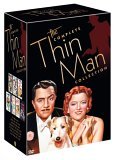

|
| weblog/wEssays archives | home | |
|
The Thin Man: Thoroughly Modern Movies (April 29, 2006) 
Sounds like a script from Oprah's show, doesn't it? Dysfunction, corruption, heavy drinking--it's all here. But the appeal is all in what's not present in today's America. The charmingly natural chemistry between William Powell and Myrna Loy and the sparkling dialog have endeared viewers for decades (as have the antics of their irrepressibly cute dog, Asta) but I have a soft spot for the wonderfully rough-around-the-edges (if not outright seamy) slice of life the films portray: if a suspect mouths off shortly after being collared, he's quickly silenced by a fist in the face (here's yer Miranda rights right here!), and the movies abound with two-bit grifters, gamblers, floozies, shifty characters and ex-cons. Nick Charles has the enviable (and let's face it, wildly improbable) gift of being at ease in both this underworld of human greed, passion and cupidity, and the glittery high-society life the couple inherited from Nora's rich father. One highlight (at least for me) in each film is some accented (Bronx or Brooklyn? I need some guidance here from a New-Yawka) ex-con, who good-naturedly reminds Nick, "Hey, Nick, doncha remember me? Two-bit Charley? Ya sent me up the river, remember? But hey, no hard feelings, you're alright!" Nick, ever so slightly taken aback, nonetheless greets the proletarian ex-con with bonhomie and makes a point of introducing Nora to the ex-con, who inevitably makes a wisecrack along the lines of, "Hey, she's a looker!", allowing Nora to look askance at her all-too-chummy-with-smalltime-hoods husband. The films sport an abundance of class-conscious Depression subtexts. While they enable the audience the escapist pleasures of vicariously sharing the high life of parties, discreet gambling boats and hot jazz clubs, Nick's breezy comfort with lower-class crooks simultaneously inoculates the couple from underclass resentment. You just gotta love Nick, who in classic anti-hero fashion, staves off pressure from both the police and media while giving the hoods who are wrongfully suspected a straight deal. He is, in other words, the personification of noblesse oblige: the embodiment of all the noble characteristics that the nation sought in the privileged class. (The role of film is, after all, to make fantasy real.) Most amazingly, the film takes the old, hackeyed gambit of assembling all the suspects into one room for the hero-detective to pick apart and makes it work, both as drama and as comedy. Beefy cops don ill-fitting waiters outfits and roughly shove recalcitrant suspects into their dining chairs ("You're not gonna pin this on me, copper!" etc.) The fancy dinner-party mis-en-scene sets up one of Nora's best lines: "Waiter, serve the nuts. (pregnant pause). I mean, serve the nuts to the guests." The Thin Man is both the epitome of and the template for sophisticated mystery-comedies, a lighter-than-air souffle of class pretensions deflated, seamy villany exposed and a constantly inebriated anti-hero who nonetheless is sharp as a tack when it comes to nailing the evil-doer or countering his adorable mate's witty barbs. Oh, and the thin man is thin--and so is Nora. Since the couple is always impeccably dressed, it's hard not to notice that they look great. Was this a reflection of starvation diets and punishing workouts, or simply a time before fattening junk food stealthily conquered America? I would peg Nick's BMI (body mass index) at about 22. (Normal is 18.5 to 25.) If you're curious about your own BMI, calculate it here. (and no fibbing; Nick don't approve of no cheating.) For more on this subject and a wide array of other topics, please visit my weblog. copyright © 2006 Charles Hugh Smith. All rights reserved in all media. I would be honored if you linked this wEssay to your site, or printed a copy for your own use. |
||
| weblog/wEssays | home |